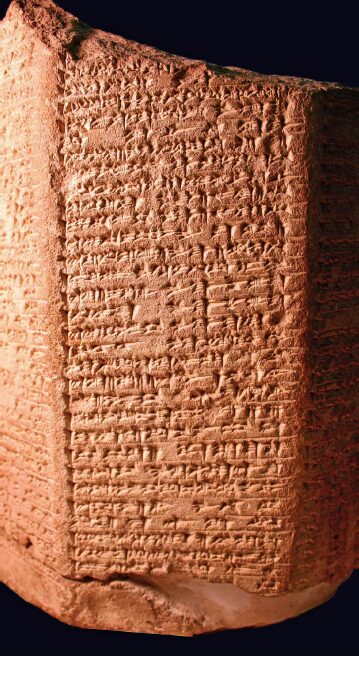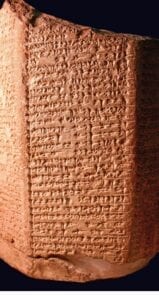Shadrach, Meshach and Abednego
 The book of Daniel provides an account of three young Jewish men who were taken captive and deported to Babylon by king Nebuchadnezzar during his first of three attacks[1] on Jerusalem in the third year of the reign of Jehoiakim king of Judah, which is 605 BC. Once in Babylon they were given the Babylonian names of Shadrach, Meshach and Abednego. Daniel tells us in chapter 3, that Nebuchadnezzar had a statue constructed and all citizens were to fall down and worship it. Those who did not worship the statue would be thrown into a blazing furnace. Shadrach, Meshach and Abednego refused to worship the statue because they worshipped God only. As a consequence, they were thrown into the fiery furnace but they did not perish and Nebuchadnezzar could see them walking around and conversing with a fourth figure who looks like a son of the gods. The king shouted Shadrach, Meshach and Abednego servants of the Most High God come out of the fire. The king praised the God of Shadrach, Meshach and Abednego and had them promoted and made them officials in his kingdom.
The book of Daniel provides an account of three young Jewish men who were taken captive and deported to Babylon by king Nebuchadnezzar during his first of three attacks[1] on Jerusalem in the third year of the reign of Jehoiakim king of Judah, which is 605 BC. Once in Babylon they were given the Babylonian names of Shadrach, Meshach and Abednego. Daniel tells us in chapter 3, that Nebuchadnezzar had a statue constructed and all citizens were to fall down and worship it. Those who did not worship the statue would be thrown into a blazing furnace. Shadrach, Meshach and Abednego refused to worship the statue because they worshipped God only. As a consequence, they were thrown into the fiery furnace but they did not perish and Nebuchadnezzar could see them walking around and conversing with a fourth figure who looks like a son of the gods. The king shouted Shadrach, Meshach and Abednego servants of the Most High God come out of the fire. The king praised the God of Shadrach, Meshach and Abednego and had them promoted and made them officials in his kingdom.
An archaeology discovery known as the Nebuchadnezzar II prism, referred to in the literature as the Hofkalender. Originally, it had eight columns (or sides), but only six pieces are preserved. These are designated Columns I to VI. Column VI has the designation EK 7834, and is in the Istanbul Archaeological Museum. It contains an unusual royal inscription, which refers to the building works to enlarge the Old Palace at Babylon. But also, it contains long lists of provincial and imperial officials. In 1982, William Shay found Shadrach, Meshach, and Abednego names on this list of officials of Nebuchadnezzar.[2] Column VI is pictured.
Nergal-sharrezar and Nebuzaradan
Then all the officials of the king of Babylon came and took seats in the middle gate: Nergak-Sharezer of Samgar, Nebo-Sarsekim a chief officer, Nergal-Sharezer[3] a high official and all the other officials of the king of Babylon.[4]
Nebuzaradan played a significant role in the events of 587-6 BC. He was a high-ranking military official, called ‘commander of the imperial Guard’ in the biblical text, perhaps reporting directly to Nebuchadnezzar. He was responsible for supervising the burning of the city (2 Kings 25:8-9; Jeremiah 39:8a, 52:12-13), tearing down the defences (2 Kings 25:10; Jeremiah 39:8b 52:14), deporting 832 captives to Babylon (2 Kings 25:11; Jeremiah 39:9; 52:15, 29), plundering the Temple (2 Kings 25:15; Jeremiah 52:17-19), and rounding up Judean officials to appear before Nebuchadnezzar (2 Kings 25:18-21; Jeremiah 52:24-27).
In his thorough and detailed analysis of EK7834, Rocio Da Riva[5] notes the names of two Babylonian officials who are recorded in the Bible as shown; Nergal-sharrezar and Nebuzaradan. As well, Da Riva reads the date the inscribed on the prism as to when it was completed as being 598 BC, which places the people it records in the same period as the events recorded in the Bible.
Conclusion
The Bible tells us that Shadrach, Meshach and Abednego became officials in Nebuchadnezzar’s kingdom. Also, it mentioned the names of Nergal-sharrezar and Nebuzaradan. The Nebuchadnezzar Column confirms that these people really did exist in Nebuchadnezzar’s kingdom and in fact, were his officials.
It is inconceivable that some people could believe that the Jews made up the Old Testament narrative to explain their exile in Babylon. The identification of biblical figures, with the same titles and correct time frame have been found on Babylonian tablets. This is not only strong evidence for the integrity of the Bible, it is proof of the accuracy and eyewitness nature of the biblical record.
Acknowledgement: I am indebted to Shelley Houser for supplying most of the information in this article. Her work can be found here.
Picture credit: Rocio Da Riva, Nebuchadnezzar II’s Prism (E S 7834): A New Edition Rocio Da Riva Nebuchadnezzar II’s Prism (EK 7834): A New Edition Abstract 2013.
[1] The other two occurred in 596 and 586 BC.[2] Willian H shea, Andrews University Seminary Studies, Spring 1982, Vol. 20 No 1, pages 48-52.
[3] The discovery of Nergal-Sharezer on Babylonian tablets has been reported here
[4] Jeremiah 39:3.
[5] Rocio Da Riva, Nebuchadnezzar II’s Prism (E S 7834): A New Edition Rocio Da Riva Nebuchadnezzar II’s Prism (EK 7834): A New Edition Abstract 2013. “Nebuchadnezzar II’s Prism (EŞ 7834): a new edition,” Zeitschrift für Assyriologie und Vorderasiatische Archäologie.
